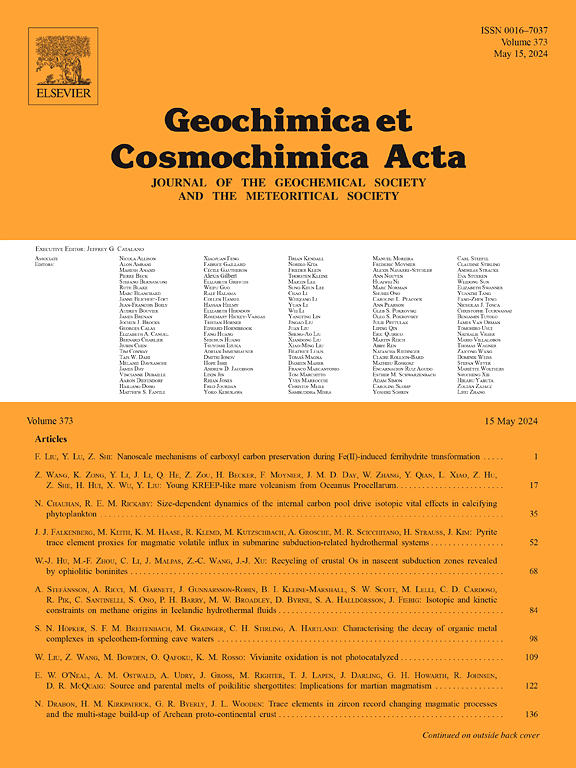Vacuum-thermal alteration of lunar soil: Evidence from iron whiskers on troilite in Chang’e-5 samples
IF 4.5
1区 地球科学
Q1 GEOCHEMISTRY & GEOPHYSICS
引用次数: 0
Abstract
The formation of a unique microstructure of minerals on the surface of airless bodies is attributed to space weathering. However, it is difficult to distinguish the contributions of meteorite impacts and solar wind to the modification of lunar soil, resulting in limited research on the space weathering mechanism of airless bodies. The thermochemical reactivity of troilite can be used to distinguish the contributions of impact events and solar wind to the modification of lunar soil and provide evidence for space weathering of lunar soil. We examined the structure of troilite particles in the Chang’e-5 lunar soil and determined whether an impact caused the thermal reaction. Microanalysis showed that troilite underwent substantial mass loss during thermal desulfurization, forming a crystallographically aligned porous structure with iron whiskers, an oxygen-rich layer, and other crystallographic and thermochemical evidence. We used an ab initio deep neural network model and thermodynamic calculations to conduct experiments and determine the anisotropy and crystal growth of troilite. The surface microstructure of troilite was transformed by the thermal reaction in the vacuum on the lunar surface. Similar structures have been found in near-Earth objects (NEOs), indicating that small bodies underwent the same impact-induced thermal events. Thus, thermal reactions in a vacuum are likely ubiquitous in the solar system and critical for space weathering alterations of the soil of airless bodies.
月球土壤的真空热蚀作用:嫦娥五号样品中铁锈岩上铁须的证据
无空气天体表面矿物独特微观结构的形成归因于空间风化。然而,由于难以区分陨石撞击和太阳风对月球土壤改良的贡献,因此对无空气天体空间风化机制的研究十分有限。特罗来石的热化学反应性可用来区分撞击事件和太阳风对月壤改造的贡献,并为月壤的空间风化提供证据。我们研究了嫦娥五号月壤中特长岩颗粒的结构,并确定了撞击是否导致了热反应。显微分析表明,特长岩在热脱硫过程中经历了大量的质量损失,形成了晶体学上排列整齐的多孔结构,其中有铁须、富氧层以及其他晶体学和热化学证据。我们使用了一个ab initio深度神经网络模型和热力学计算来进行实验,并确定了特罗来石的各向异性和晶体生长。在月球表面的真空中,热反应改变了透辉石的表面微观结构。在近地天体(NEOs)中也发现了类似的结构,这表明小天体也经历了同样的撞击引起的热反应。因此,真空中的热反应在太阳系中可能无处不在,对于无空气天体土壤的空间风化改变至关重要。
本文章由计算机程序翻译,如有差异,请以英文原文为准。
求助全文
约1分钟内获得全文
求助全文
来源期刊

Geochimica et Cosmochimica Acta
地学-地球化学与地球物理
CiteScore
9.60
自引率
14.00%
发文量
437
审稿时长
6 months
期刊介绍:
Geochimica et Cosmochimica Acta publishes research papers in a wide range of subjects in terrestrial geochemistry, meteoritics, and planetary geochemistry. The scope of the journal includes:
1). Physical chemistry of gases, aqueous solutions, glasses, and crystalline solids
2). Igneous and metamorphic petrology
3). Chemical processes in the atmosphere, hydrosphere, biosphere, and lithosphere of the Earth
4). Organic geochemistry
5). Isotope geochemistry
6). Meteoritics and meteorite impacts
7). Lunar science; and
8). Planetary geochemistry.
 求助内容:
求助内容: 应助结果提醒方式:
应助结果提醒方式:


